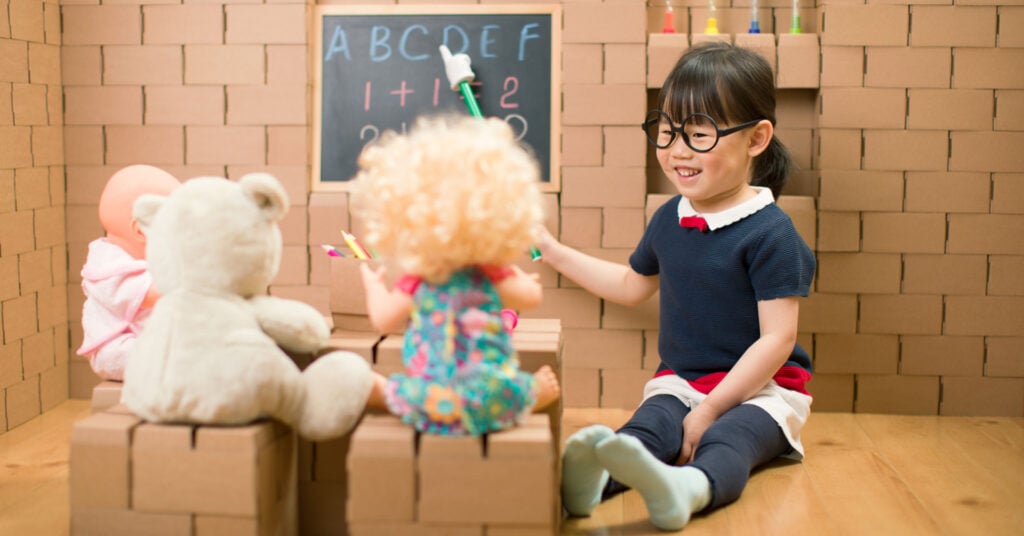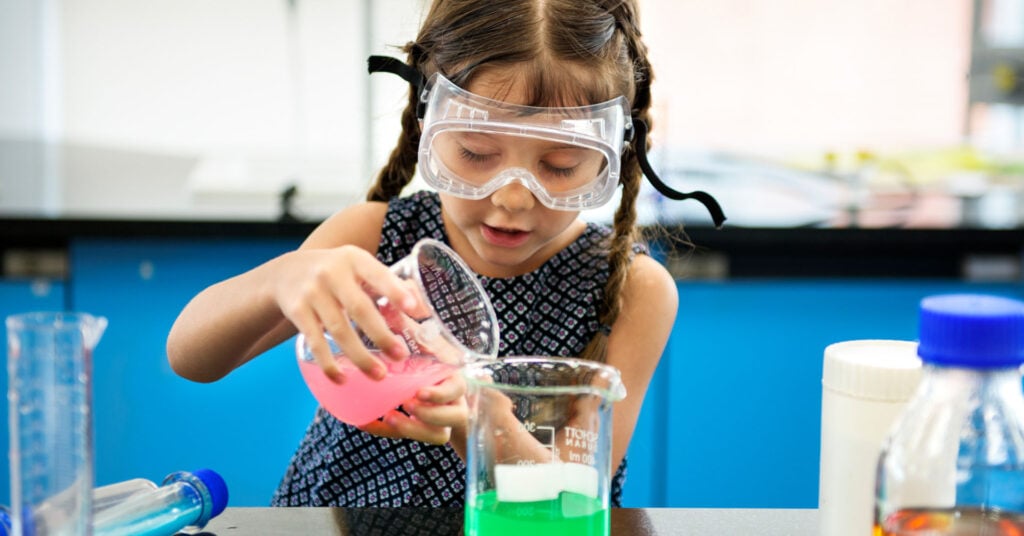THE FOUR STAGES OF PIAGET'S COGNITIVE DEVELOPEMENT THEORY
Stages Of Development
Jean Piaget’s theory of cognitive development suggests that children move through four different stages of intellectual development which reflect the increasing sophistication of children’s thought.
Piaget’s Theory
- Piaget’s theory places a strong emphasis on the active role that children play in their own cognitive development.
- According to Piaget, children are not passive recipients of information; instead, they actively explore and interact with their surroundings.
- This active engagement with the environment is crucial because it allows them to gradually build their understanding of the world.
Each child goes through the stages in the same order (but not all at the same rate), and child development is determined by biological maturation and interaction with the environment.
At each stage of development, the child’s thinking is qualitatively different from the other stages, that is, each stage involves a different type of intelligence.
| Stage | Age | Goal |
|---|---|---|
| Sensorimotor | Birth to 18-24 months | Object permanence |
| Preoperational | 2 to 7 years old | Symbolic thought |
| Concrete operational | Ages 7 to 11 years | Logical thought |
| Formal operational | Adolescence to adulthood | Scientific reasoning |
Although no stage can be missed out, there are individual differences in the rate at which children progress through stages, and some individuals may never attain the later stages.
Piaget did not claim that a particular stage was reached at a certain age – although descriptions of the stages often include an indication of the age at which the average child would reach each stage.
The Sensorimotor Stage
Ages: Birth to 2 Years
The first stage is the sensorimotor stage, and during this stage, the infant focuses on physical sensations and on learning to coordinate their body.

Major Characteristics and Developmental Changes:
- The infant learns about the world through their senses and through their actions (moving around and exploring their environment).
- During the sensorimotor stage, a range of cognitive abilities develop. These include: object permanence;
self-recognition (the child realizes that other people are separate from them); deferred imitation; and representational play. - They relate to the emergence of the general symbolic function, which is the capacity to represent the world mentally
- At about 8 months, the infant will understand the permanence of objects and that they will still exist even if they can’t see them and the infant will search for them when they disappear.
During the beginning of this stage, the infant lives in the present. It does not yet have a mental picture of the world stored in its memory therefore it does not have a sense of object permanence.
If it cannot see something, then it does not exist. This is why you can hide a toy from an infant, while it watches, but it will not search for the object once it has gone out of sight.
The main achievement during this stage is object permanence – knowing that an object still exists, even if it is hidden. It requires the ability to form a mental representation (i.e., a schema) of the object.
Towards the end of this stage the general symbolic function begins to appear where children show in their play that they can use one object to stand for another. Language starts to appear because they realize that words can be used to represent objects and feelings.
The child begins to be able to store information that it knows about the world, recall it, and label it.
Individual Differences
- Cultural Practices: In some cultures, babies are carried on their mothers’ backs throughout the day. This constant physical contact and varied stimuli can influence how a child perceives their environment and their sense of object permanence.
- Gender Norms: Toys assigned to babies can differ based on gender expectations. A boy might be given more cars or action figures, while a girl might receive dolls or kitchen sets. This can influence early interactions and sensory explorations.
Learn More: The Sensorimotor Stage of Cognitive Development
The Preoperational Stage
Ages: 2 – 7 Years
Piaget’s second stage of intellectual development is the preoperational stage. It takes place between 2 and 7 years. At the beginning of this stage, the child does not use operations, so the thinking is influenced by the way things appear rather than logical reasoning.
A child cannot conserve which means that the child does not understand that quantity remains the same even if the appearance changes.
Furthermore, the child is egocentric; he assumes that other people see the world as he does. This has been shown in the three mountains study.
As the preoperational stage develops, egocentrism declines, and children begin to enjoy the participation of another child in their games, and let’s pretend play becomes more important.

Toddlers often pretend to be people they are not (e.g. superheroes, policemen), and may play these roles with props that symbolize real-life objects. Children may also invent an imaginary playmate.
Major Characteristics and Developmental Changes:
- Toddlers and young children acquire the ability to internally represent the world through language and mental imagery.
- During this stage, young children can think about things symbolically. This is the ability to make one thing, such as a word or an object, stand for something other than itself.
- A child’s thinking is dominated by how the world looks, not how the world is. It is not yet capable of logical (problem-solving) type of thought.
- Moreover, the child has difficulties with class inclusion; he can classify objects but cannot include objects in sub-sets, which involves classifying objects as belonging to two or more categories simultaneously.
- Infants at this stage also demonstrate animism. This is the tendency for the child to think that non-living objects (such as toys) have life and feelings like a person’s.
By 2 years, children have made some progress toward detaching their thoughts from the physical world. However, have not yet developed logical (or “operational”) thought characteristics of later stages.
Thinking is still intuitive (based on subjective judgments about situations) and egocentric (centered on the child’s own view of the world).
Individual Differences
- Cultural Storytelling: Different cultures have unique stories, myths, and folklore. Children from diverse backgrounds might understand and interpret symbolic elements differently based on their cultural narratives.
- Race & Representation: A child’s racial identity can influence how they engage in pretend play. For instance, a lack of diverse representation in media and toys might lead children of color to recreate scenarios that don’t reflect their experiences or background.
Learn More: The Preoperational Stage of Cognitive Development
The Concrete Operational Stage
Ages: 7 – 11 Years
By the beginning of the concrete operational stage, the child can use operations (a set of logical rules) so they can conserve quantities, realize that people see the world in a different way (decentring), and demonstrate improvement in inclusion tasks. Children still have difficulties with abstract thinking.

Major Characteristics and Developmental Changes:
- During this stage, children begin to think logically about concrete events.
- Children begin to understand the concept of conservation; understanding that, although things may change in appearance, certain properties remain the same.
- During this stage, children can mentally reverse things (e.g., picture a ball of plasticine returning to its original shape).
- During this stage, children also become less egocentric and begin to think about how other people might think and feel.
The stage is called concrete because children can think logically much more successfully if they can manipulate real (concrete) materials or pictures of them.
Piaget considered the concrete stage a major turning point in the child’s cognitive development because it marks the beginning of logical or operational thought. This means the child can work things out internally in their head (rather than physically try things out in the real world).
Children can conserve number (age 6), mass (age 7), and weight (age 9). Conservation is the understanding that something stays the same in quantity even though its appearance changes.
But operational thought is only effective here if the child is asked to reason about materials that are physically present. Children at this stage will tend to make mistakes or be overwhelmed when asked to reason about abstract or hypothetical problems.
Individual Differences
- Cultural Context in Conservation Tasks: In a society where resources are scarce, children might demonstrate conservation skills earlier due to the cultural emphasis on preserving and reusing materials.
- Gender & Learning: Stereotypes about gender abilities, like “boys are better at math,” can influence how children approach logical problems or classify objects based on perceived gender norms.
Learn More: The Concrete Operational Stage of Development
The Formal Operational Stage
Ages: 12 and Over
The formal operational period begins at about age 11. As adolescents enter this stage, they gain the ability to think in an abstract manner, the ability to combine and classify items in a more sophisticated way, and the capacity for higher-order reasoning.

Adolescents can think systematically and reason about what might be as well as what is (not everyone achieves this stage). This allows them to understand politics, ethics, and science fiction, as well as to engage in scientific reasoning.
Adolescents can deal with abstract ideas: e.g. they can understand division and fractions without having to actually divide things up and solve hypothetical (imaginary) problems.
Major Characteristics and Developmental Changes:
- Concrete operations are carried out on things whereas formal operations are carried out on ideas. Formal operational thought is entirely freed from physical and perceptual constraints.
- During this stage, adolescents can deal with abstract ideas (e.g. no longer needing to think about slicing up cakes or sharing sweets to understand division and fractions).
- They can follow the form of an argument without having to think in terms of specific examples.
- Adolescents can deal with hypothetical problems with many possible solutions. E.g. if asked ‘What would happen if money were abolished in one hour’s time? they could speculate about many possible consequences.
From about 12 years children can follow the form of a logical argument without reference to its content. During this time, people develop the ability to think about abstract concepts, and logically test hypotheses.
This stage sees the emergence of scientific thinking, formulating abstract theories and hypotheses when faced with a problem.
Individual Differences
- Culture & Abstract Thinking: Cultures emphasize different kinds of logical or abstract thinking. For example, in societies with a strong oral tradition, the ability to hold complex narratives might develop prominently.
- Gender & Ethics: Discussions about morality and ethics can be influenced by gender norms. For instance, in some cultures, girls might be encouraged to prioritize community harmony, while boys might be encouraged to prioritize individual rights.

How Piaget Developed the Theory
Piaget was employed at the Binet Institute in the 1920s, where his job was to develop French versions of questions on English intelligence tests. He became intrigued with the reasons children gave for their wrong answers to the questions that required logical thinking.
He believed that these incorrect answers revealed important differences between the thinking of adults and children.
Piaget branched out on his own with a new set of assumptions about children’s intelligence:
- Children’s intelligence differs from an adult’s in quality rather than in quantity. This means that children reason (think) differently from adults and see the world in different ways.
- Children actively build up their knowledge about the world. They are not passive creatures waiting for someone to fill their heads with knowledge.
- The best way to understand children’s reasoning is to see things from their point of view.
Piaget did not want to measure how well children could count, spell or solve problems as a way of grading their I.Q. What he was more interested in was the way in which fundamental concepts like the very idea of number, time, quantity, causality, justice, and so on emerged.
Piaget studied children from infancy to adolescence using naturalistic observation of his own three babies and sometimes controlled observation too. From these, he wrote diary descriptions charting their development.
He also used clinical interviews and observations of older children who were able to understand questions and hold conversations.
Mcleod, S. (2019). Object Permanence | Simply Psychology. Simplypsychology.org; Simply Psychology. https://www.simplypsychology.org/Object-Permanence.html


No comments:
Post a Comment